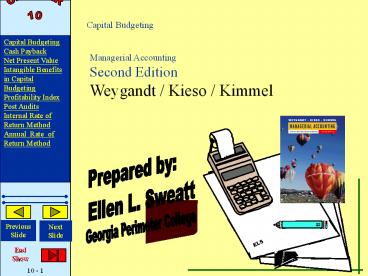Chapter 3- Process Cost Accounting - PowerPoint PPT Presentation
1 / 30
Title:
Chapter 3- Process Cost Accounting
Description:
Uses estimated Cash Inflows and Outflows- not accrual-based income statement numbers. ... May be critical factor if company needs a fast turnaround of money. ... – PowerPoint PPT presentation
Number of Views:55
Avg rating:3.0/5.0
Title: Chapter 3- Process Cost Accounting
1
Capital Budgeting
2
Capital Budgeting
3
Capital Budgeting Is...
- The process of making capital expenditure
decisions in business. - Choosing among many capital projects to find the
one(s) that will MAXIMIZE a companys return on
its financial investment.
4
Capital Budgeting Authorization
5
Capital Budgeting
- Uses estimated Cash Inflows and Outflows- not
accrual-based income statement numbers.
6
Capital Budgeting
Illustration 10-2
- Cash Outflows
- Initial investment
- Repairs and investment
- Increased operating cost
- Overhaul of equipment
- Cash Inflows
- Sale of old equipment
- Increased cash received from customers
- Reduced cash outflows related to operating costs
- Salvage value of equipment when project is
completed.
7
Data To Be Used In Following Examples
Illustration 10-3
Initial investment 130,000 Estimated useful
life 10 years Estimated salvage value - 0 -
Estimated annual cash flows Cash inflow from
customers 200,000 Cash outflows for
operating costs 176,000 Net annual cash
inflow 24,000
8
Cash Payback Technique
- A capital budgeting technique that identifies the
time period required to recover the cost of a
capital investment from the annual cash inflow
produced by the investment.
The shorter the payback period, the better.
9
Cash Payback Technique
Illustration 10-4
130,000 ? 24,000 5.42 years
10
Cash Payback
- Advantages
- May be critical factor if company needs a fast
turnaround of money. - Easy to compute and understand.
- Disadvantages
- Ignores profitability of project.
- Ignore time value of money.
11
Net Present Value
- The difference that results when the original
capital outlay is subtracted from the discounted
cash inflows.
12
Net Present Value Method
- A method used in capital budgeting in which cash
inflows are discounted to their present value and
then compared to the capital outlay required by
the investment.
13
Discounted Cash Flow Technique
- A capital budgeting technique that considers both
the estimated total cash inflows from the
investment and the time value of money.
14
Net Present Value Criteria
Illustration 10-5
15
Net Present Value
- Annual cash inflows are 24,000 for all ten
years.
The analysis of the proposal by the Net Present
Value method is
The proposed capital expenditure is acceptable
at the 12 required rate of return because the
NPV is positive.
16
Choosing A Discount Rate
- A company uses a discount rate that is equal to
its cost of capital. - The cost of capital is a weighted average of the
rates paid on borrowed funds and funds from
investors in the companys stock. - A discount rate has two elements
- a cost of capital element
- a risk element.
- Companies often assume the risk element is zero.
17
Cost of Capital
- The average rate of return that the firm must pay
to obtain borrowed and equity funds.
18
Net Present Value Assumptions
- All cash flows come at the end of each year.
- All cash flows are immediately reinvested in
another project that has a similar return. - All cash flows can be predicted with certainty.
19
Intangible Benefits
- Increased quality
- Safety
- Employee loyalty
- To avoid rejecting projects that should be
accepted, two possible approaches are suggested - Calculate NPV ignoring intangible benefits and if
NPV is negative, ask if intangible benefits are
worth at least the negative NPV. - Project rough, conservative estimates of the
value of the intangible benefits and include
those in NPV calculation.
20
Mutually Exclusive Projects
10 year life 12 discount rate
21
Mutually Exclusive Projects
- Revised investment information for the two
projects is
22
Profitability Index
- A method of comparing alternative projects that
takes into account - the size of the investment
- its discounted future cash flows.
23
Profitability Index
- Revised investment information for the two
projects is
Project A is better because it has the higher
profitability index.
24
Post-audit
- A thorough evaluation of how well a projects
actual performance matches the projections made
when the project was proposed.
25
Illustration 10-21
Internal Rate of Return
26
Internal Rate of Return
- The rate that will cause the present value of the
proposed capital expenditure to equal the present
value of the expected annual cash inflows.
27
Internal Rate of Return Method
- A method used in capital budgeting that results
in finding the interest yield of the potential
investment.
28
Annual Rate of Return Method
- The determination of the profitability of a
capital expenditure by dividing expected annual
net income by the average investment
29
Annual Rate of Return Method
Illustration 10-23
Illustration 10-24
Sales 200,000 Less Cost and expenses
Manufacturing costs 132,000 Depreciation
expense (130,000 ? 5) 26,000 Selling and
administrative expenses 22,000
180,000 Income before income taxes 20,000 Income
tax expense 7,000 Net income 13,000
Illustration 10-25
13,000 ? 65,000 20
30
(No Transcript)































